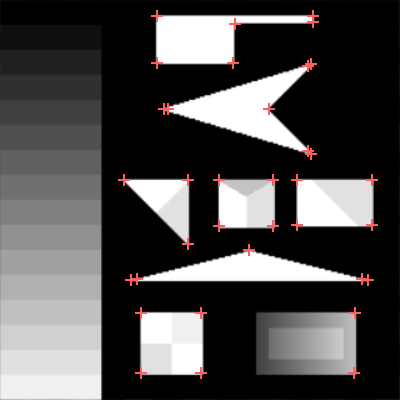You are here: Start » AVL.NET » AVL.DetectCorners_CornerResponse(AvlNet.Image, AvlNet.Region, AvlNet.CornerResponseMethod, int, float?, AvlNet.Point2D[], AvlNet.Image)
AVL.DetectCorners_CornerResponse(AvlNet.Image, AvlNet.Region, AvlNet.CornerResponseMethod, int, float?, AvlNet.Point2D[], AvlNet.Image)
Detects corners using corner response method.
| Namespace: | AvlNet |
|---|---|
| Assembly: | AVL.NET.dll |
Syntax
public static void DetectCorners_CornerResponse( AvlNet.Image inMonoImage, AvlNet.Region inRoi, AvlNet.CornerResponseMethod inCornerResponseMethod, int inKernelSize, float? inThreshold, out AvlNet.Point2D[] outCorners, out AvlNet.Image outCornerResponseImage )
Parameters
- inMonoImage
- Type: AvlNet.Image
Input image - inRoi
- Type: AvlNet.Region
Range of pixels to be processed, or null. - inCornerResponseMethod
- Type: AvlNet.CornerResponseMethod
Method for computing corner response - inKernelSize
- Type: System.Int32
Method kernel size - inThreshold
- Type: System.Nullable<System.Single>
Threshold for corner response value, between 0 and 255, default value is taken from SelectThresholdValue on outCornerResponseImage and entropy method, or null. - outCorners
- Type: AvlNet.Point2D
- outCornerResponseImage
- Type: AvlNet.Image
Description
The operation detects corners using either Harris or Kanade-Tomasi corner response method,
depending on inCornerResponseMethod.
For every square window of size inKernelSize a convolution matrix is computed:
\[M = \left(\begin{array}{ccc}
\sum g_r^2 & \sum g_c g_r \\
\sum g_c g_r & \sum g_c^2
\end{array} \right) \]
where the summation is performed over the whole window
and \(g_r, g_c\) denote horizontal and vertical gradient respectively at the point.
Harris' corner response is computed the following way:
\[H = \mathrm{det}(M) - k \mathrm{tr}^2(M) \]
where k is a constant set to 0.01.
Kanade-Tomasi corner response is given by:
\[KT = \mathrm{min}(\lambda_1, \lambda_2)\]
where \(\lambda_1, \lambda_2\) are eigenvalues of the convolution matrix.
Values H or KT give corner response image.
Then a few steps are performed in order to extract corner points. First, the normalized corner response function is thresholded with inThreshold with a small hysteresis, then the remained points are split into connected regions (blobs) and the center of each blob is determined.
Examples
 |
 |
DetectCorners_CornerResponse with inThreshold=50, methods Harris and Kanade-Tomasi respectively.
Remarks
Both methods give similar results and are quite fast. However, they tend to be less accurate than DetectCorners_Foerstner.
Errors
| Error type | Description |
|---|---|
| DomainError | Unknown algorithm in DetectCorners_CornerResponse. |


